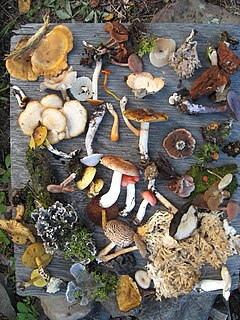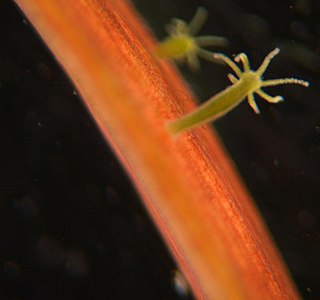Related Research Articles

The Convention on Biological Diversity (CBD), known informally as the Biodiversity Convention, is a multilateral treaty. The convention has three main goals: the conservation of biological diversity ; the sustainable use of its components; and the fair and equitable sharing of benefits arising from genetic resources. Its objective is to develop national strategies for the conservation and sustainable use of biological diversity, and it is often seen as the key document regarding sustainable development.

The Fabales are an order of flowering plants included in the rosid group of the eudicots in the Angiosperm Phylogeny Group II classification system. In the APG II circumscription, this order includes the families Fabaceae or legumes, Quillajaceae, Polygalaceae or milkworts, and Surianaceae. Under the Cronquist system and some other plant classification systems, the order Fabales contains only the family Fabaceae. In the classification system of Dahlgren the Fabales were in the superorder Fabiflorae with three families corresponding to the subfamilies of Fabaceae in APG II. The other families treated in the Fabales by the APG II classification were placed in separate orders by Cronquist, the Polygalaceae within its own order, the Polygalales, and the Quillajaceae and Surianaceae within the Rosales.
A race is a categorization of humans based on shared physical or social qualities into groups generally viewed as distinct within a given society. The term was first used to refer to speakers of a common language, and then to denote national affiliations. By the 17th century, the term began to refer to physical (phenotypical) traits. Modern science regards race as a social construct, an identity which is assigned based on rules made by society. While partly based on physical similarities within groups, race does not have an inherent physical or biological meaning.

Biodiversity is the biological variety and variability of life on Earth. Biodiversity is a measure of variation at the genetic, species, and ecosystem level. Terrestrial biodiversity is usually greater near the equator, which is the result of the warm climate and high primary productivity. Biodiversity is not distributed evenly on Earth, and is richer in the tropics. These tropical forest ecosystems cover less than 10% of earth's surface and contain about 90% of the world's species. Marine biodiversity is usually higher along coasts in the Western Pacific, where sea surface temperature is highest, and in the mid-latitudinal band in all oceans. There are latitudinal gradients in species diversity. Biodiversity generally tends to cluster in hotspots, and has been increasing through time, but will be likely to slow in the future as a primary result of deforestation. It encompasses the evolutionary, ecological, and cultural processes that sustain life.

The Cartagena Protocol on Biosafety to the Convention on Biological Diversity is an international agreement on biosafety as a supplement to the Convention on Biological Diversity (CBD) effective since 2003. The Biosafety Protocol seeks to protect biological diversity from the potential risks posed by genetically modified organisms resulting from modern biotechnology.

Genetic diversity is the total number of genetic characteristics in the genetic makeup of a species, it ranges widely from the number of species to differences within species and can be attributed to the span of survival for a species. It is distinguished from genetic variability, which describes the tendency of genetic characteristics to vary.
Traditional knowledge (TK), indigenous knowledge (IK) and local knowledge generally refer to knowledge systems embedded in the cultural traditions of regional, indigenous, or local communities. According to the World Intellectual Property Organization (WIPO) and the UN, traditional knowledge and traditional cultural expressions (TCE) are both types of indigenous knowledge.

The International Day for Biological Diversity is a United Nations–sanctioned international day for the promotion of biodiversity issues. It is currently held on May 22.
Australian Biological Resources Study (ABRS) is a project undertaken by Parks Australia Division of Australia's Department of the Environment, Water, Heritage and the Arts (DEWHA).

The Center for Biological Diversity is a nonprofit membership organization known for its work protecting endangered species through legal action, scientific petitions, creative media and grassroots activism. It was founded in 1989 by Kieran Suckling, Peter Galvin, Todd Schulke and Robin Silver. The Center is based in Tucson, Arizona, with its headquarters in the historic Owls club building, and has offices and staff in New Mexico, Nevada, California, Oregon, Illinois, Minnesota, Alaska, Vermont, Florida and Washington, D.C.

The wildlife of Ghana is composed of its biodiversity of flora and fauna.

Sessility is the biological property of an organism describing its lack of a means of self-locomotion. Sessile organisms for which natural motility is absent are normally immobile. This is distinct from the botanical concept of sessility, which refers to an organism or biological structure attached directly by its base without a stalk.

The International Year of Biodiversity (IYB) was a year-long celebration of biological diversity and its importance, taking place internationally in 2010. Coinciding with the date of the 2010 Biodiversity Target, the year was declared by the 61st session of the United Nations General Assembly in 2006.
The National Biodiversity Authority (NBA) is a statutory autonomous body under the Ministry of Environment, Forests and climate change, Government of India established in 2003 to implement the provisions under the Biological Diversity Act, 2002, after India signed Convention on Biological Diversity (CBD) in 1992.
The Biological Diversity Act, 2002 is an Act enacted by the Parliament of India for the preservation of biological diversity in India, and provides mechanism for equitable sharing of benefits arising out of the use of traditional biological resources and knowledge. The Act was enacted to meet the obligations under the Convention on Biological Diversity (CBD), because India is a party of the convention {meeting}.

Biodiversity loss includes the worldwide extinction of different species, as well as the local reduction or loss of species in a certain habitat, resulting in a loss of biological diversity. The latter phenomenon can be temporary or permanent, depending on whether the environmental degradation that leads to the loss is reversible through ecological restoration/ecological resilience or effectively permanent. The current global extinction, has resulted in a biodiversity crisis being driven by human activities which push beyond the planetary boundaries and so far has proven irreversible.
Plants of the World Online is an online database published by the Royal Botanic Gardens, Kew. It was launched in March 2017 with the ultimate aim being "to enable users to access information on all the world's known seed-bearing plants by 2020". The initial focus was on tropical African Floras, particularly Flora Zambesiaca, Flora of West Tropical Africa and Flora of Tropical East Africa.
Plant genetic resources are plant genetic materials of actual or potential value. They describe the variability within plants that comes from human and natural selection over millennia. Their intrinsic value mainly concerns agricultural crops.
References
- ↑ "ISI Web of Knowledge". Archived from the original on 18 May 2006. Retrieved 11 February 2008.